Access layer virtualisation helps simplify networks and reduce costs
21 October 2014, Shenzhen, China – ZTE Corporation (“ZTE”) (H share stock code: 0763. HK/A share stock code: 000063.SZ), a publicly-listed global provider of telecommunications equipment, network solutions and mobile devices, has launched the ZTE ElasticNet SDN (software-defined networking) IPRAN (internet protocol radio access network) solution.
The solution introduces SDN virtualisation technology to an IPRAN network to virtualise massive access-layer equipment, simplifying network structures and operations and maintenance (O&M) and offering an intelligent, maintainable IPRAN bearer network to meet operators’ current and future needs.
IPRAN is widely used in mobile network backhaul to bear 2G/3G/LTE and other mobile services, using the IP/MPLS (internet protocol/multi-protocol label switching). After the access layer introduces layer 3, IGP/BGP/LDP/TE/PW/BFD configuration takes place. An IPRAN local access network often has thousands of devices, so personnel managing the network must be highly qualified because of the complex network O&M.
In the LTE era, eNB (evolved Node B) coverage is much less than earlier generation base stations, requiring more base stations. It is estimated that 2-3 more eNBs are required than existing base stations, and this also increases the number of backhaul devices. This expansion brings its own network design, service configuration, and O&M problems and pressures.
ZTE’s ElasticNet SDN IPRAN solution virtualises massive remote access-layer equipment into the boards of convergence-layer equipment, and convergence/access layer equipment forms a large virtual cluster system, simplifying the IPRAN equipment and improving automatic network deployment, O&M and network service capability.
The IPRAN solution is based on unified standard SDN northbound and southbound interfaces to help ensure an open network capability and to create application value to meet the requirements of new LTE service deployment and rapid innovation.
Fan Chengfa, chief engineer of ZTE’s Bearer Network product line, said: "With the growing popularity of mobile Internet, mobile bearer networks are taking on an increasingly important role, and meanwhile higher labour costs are creating more pressure for efficient network operation. Applying SDN to the IPRAN combines software-based automatic management and application-on-demand to help operators further simplify O&M and enrich service capabilities so as to provide customers with better service.”
The ZTE ElasticNet SDN IPRAN uses an external stand-alone controller to quickly respond to and follow the development of SDN technology. It uses the standard Openflow protocol and is compatible with other vendors for cross-vendor service deployment, complying with SDN concepts and development trends.
